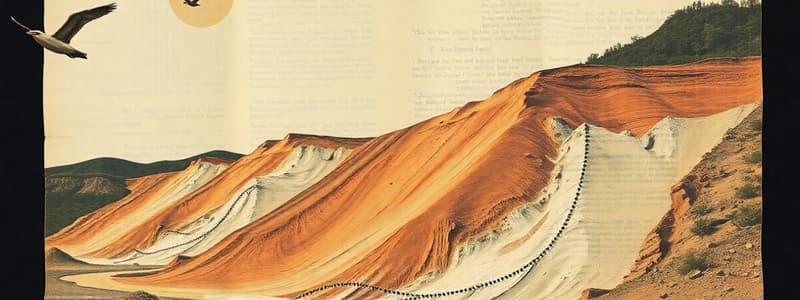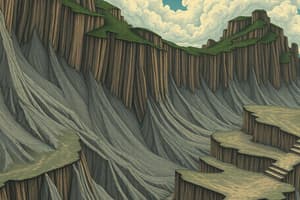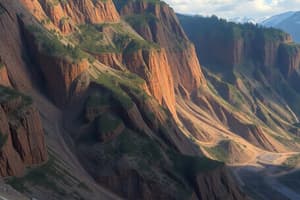Podcast
Questions and Answers
What is the primary characteristic that distinguishes debris flow from other types of mass wasting?
What is the primary characteristic that distinguishes debris flow from other types of mass wasting?
- It transports materials as a solid mass.
- It is composed of diverse sizes of rock fragments and soil. (correct)
- It consists solely of sand-sized materials.
- It relies solely on gravitational forces.
What primarily triggers the movement of earthflow?
What primarily triggers the movement of earthflow?
- Low temperatures
- Water saturation of sediment (correct)
- Earthquake vibrations
- High wind speeds
Which type of mass wasting is described as a slow downslope motion that can bend tree trunks?
Which type of mass wasting is described as a slow downslope motion that can bend tree trunks?
- Creep (correct)
- Debris flow
- Earthflow
- Mudflow
What can lead to the creation of lahar, a type of mudflow?
What can lead to the creation of lahar, a type of mudflow?
What speed can debris flows reach due to their fluid properties?
What speed can debris flows reach due to their fluid properties?
What primarily controls sediment deposition and stability in elevated geographical areas?
What primarily controls sediment deposition and stability in elevated geographical areas?
What type of particles primarily make up earthflow materials?
What type of particles primarily make up earthflow materials?
Which mass wasting type is known for moving as a fluid due to its high internal water pressure?
Which mass wasting type is known for moving as a fluid due to its high internal water pressure?
Which type of mass wasting is characterized by a slow, short-distance movement of semi-consolidated earth material?
Which type of mass wasting is characterized by a slow, short-distance movement of semi-consolidated earth material?
What type of mass wasting is considered one of the fastest and most destructive?
What type of mass wasting is considered one of the fastest and most destructive?
Which of the following triggers can cause a slump?
Which of the following triggers can cause a slump?
In a debris flow, what characterizes the movement of materials?
In a debris flow, what characterizes the movement of materials?
What is a common consequence of slumps occurring underwater?
What is a common consequence of slumps occurring underwater?
What factors can decrease the resistance of rock material to gravitational forces?
What factors can decrease the resistance of rock material to gravitational forces?
What is the essential criterion for classifying the type of slump?
What is the essential criterion for classifying the type of slump?
Flashcards
Mass Wasting
Mass Wasting
The downslope movement of earth material due to gravity, often triggered by factors like water content increase or seismic activity.
Slump
Slump
A slow, short-distance downslope movement of semi-consolidated earth material, occurring on a curved or planar sliding surface.
Rockslide
Rockslide
A fast, dangerous downslope movement of rock material with high speed and destructive force.
Debris Flow
Debris Flow
Signup and view all the flashcards
Earthflow
Earthflow
Signup and view all the flashcards
Triggering Mechanisms (Mass Wasting)
Triggering Mechanisms (Mass Wasting)
Signup and view all the flashcards
Sediment Stability
Sediment Stability
Signup and view all the flashcards
Consolidated/Unconsolidated Deposits
Consolidated/Unconsolidated Deposits
Signup and view all the flashcards
Creep
Creep
Signup and view all the flashcards
Mudflow
Mudflow
Signup and view all the flashcards
Lahar
Lahar
Signup and view all the flashcards
Criteria for classifying mass wasting
Criteria for classifying mass wasting
Signup and view all the flashcards
Study Notes
Types of Mass Wasting
- Mass wasting is the downslope movement of earth material due to disrupted stability, often triggered by gravity, water, or seismic activity.
- Common types include slumps, rockslides, debris flows, and earthflows.
Slumps
- Slumps are slow, short-distance movements of semi-consolidated material.
- The sliding surface can be curved or planar.
- Triggered by high water influx (heavy rain) or seismic activity.
- Can occur underwater and cause tsunamis.
Rockslides
- Rockslides are a fast, dangerous type of mass wasting.
- Rocks detach and move downslope at high speeds.
- Triggered by heavy rain and seismic activity (like earthquakes).
- Reduced rock strength from increased water content and shaking contributes to movement.
Debris Flows
- Debris flows involve a diverse mix of materials, from boulders to sand, in water-saturated states.
- The material is transported as if it were a fluid, reaching high speeds (e.g., 30+ km/h).
- Internal pore water pressure drives the flow.
Earthflows
- Earthflows involve mud-sized, water-saturated materials moving downslope at variable speeds.
- Triggered primarily by water saturation, which reduces the material's shearing strength.
- Characterized by high water content.
Other Forms of Mass Wasting
- Creep is a very slow downslope movement of material that can bend tree trunks.
- Mudflows are also triggered by high water content and can be extremely destructive, particularly volcanic mudflows (lahars).
- Lahars are associated with volcanic eruptions and the mixing of pyroclastic material with water sources (like snow).
- Mass wasting can impact infrastructure, such as roads.
Studying That Suits You
Use AI to generate personalized quizzes and flashcards to suit your learning preferences.




